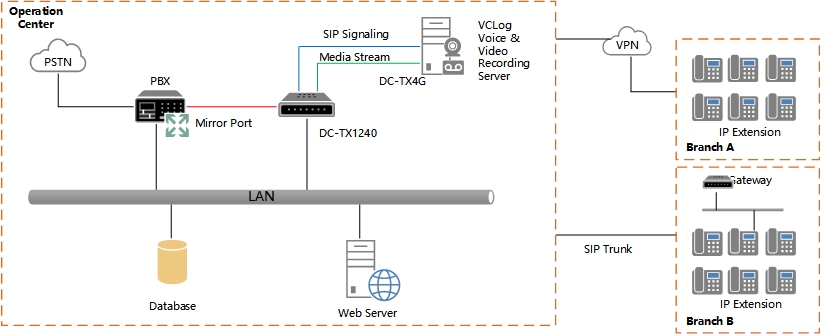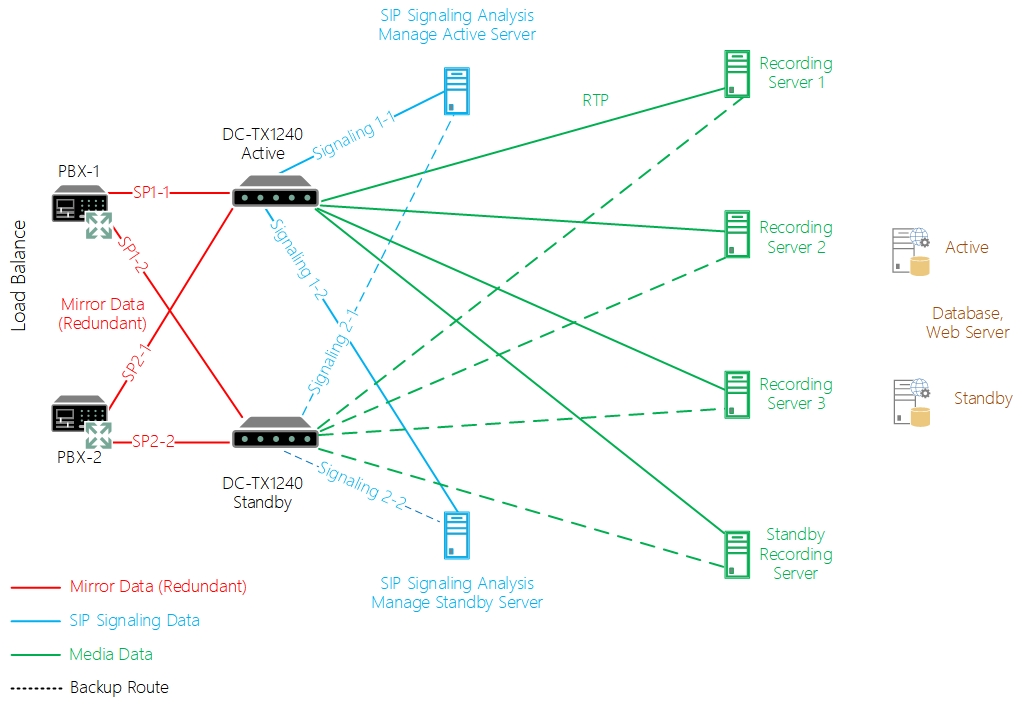| With the embrace of big data and artificial intelligence era, more and more data are clustered together. Under such circumstances, how can we obtain more effective and original data to provide it to the voice and video recording server of the contact center?
In a centralized big data center, we usually acquire the raw data of voice and video recording through the mirror port of the network switch. In order to manage and distribute the data of the mirror port more effectively, we can use SpanX series DC-TX124x to collect, filter and distribute the data. The N+N or N+1 voice and video recording solutions are two options for flexible deployment. When artificial intelligence required to forward voice and video data in real time, we can use SpanX series DC-TX4G. This helps to ensure the lossless distribution of data, increase the processing performance of standard servers and reduce or balance the load of server CPU. SpanX is specially designed for high-density and high-reliability VoIP voice and video recording system, which can intelligently collect, filter, assemble and distribute data. This significantly reduces the loss rate of voice and video recording, ensure the data validity and improve the reliability of the system. |
 |
Typical Case |
| This enterprise voice communication is connected based on SIP protocol. The IP network switch adopts dual server load balancing mechanism. Some customers’ voice data are connected to IP switch through SIP trunk while some customers’ voice data are directly registered to IP switch through SIP phone terminal. There are 2 SIP trunks (redundant, 4 in total), the number of telephone terminals is about 10,000 and the overall concurrent volume is about 60%. |  |
System Architecture |

Figure-1 Overall Architecture
Equipment such as Private Branch Exchange (PBX) and recording system are deployed in the operation center. Users register with the center through network or SIP trunk and communicate with PSTN through the operation center. The voice data between the internal extensions of the enterprise will also flow through PBX in the operation center. IP data lossless distributor DC-TX1240, SIP signalling analysis and management server, recording server, database and Web server are required to access to office LAN.

Figure- 2 Network Architecture of Recording Related Equipment
Two load-balanced PBX-1 and PBX-2 provide two redundant mirror ports respectively, and are connected to the active and standby machines of the data distributor:
1. PBX-1 provides one set of redundant mirror ports SP1-1 and SP1-2, which send the same call data at the same time. SP1-1 is connected with DC-TX1240 active machine and SP1-2 is connected with DC-TX1240 standby machine.
2. PBX-2 provides a set of redundant mirror ports SP2-1 and SP2-2, which send the same call data at the same time. SP2-1 is connected with DC-TX1240 active machine and SP2-2 is connected with DC-TX1240 standby machine.
IP data lossless distributor DC-TX1240 (one active machine and one standby machine) separates the mirror data of the call into SIP signalling data and RTP voice data. SIP signalling data is sent to SIP signalling analysis and management server, while RTP voice stream is distributed to each recording server according to port number rule. By separating and distributing data, the operating load of single server can be greatly reduced.
Active and standby operating mechanism of DC-TX1240IP data lossless distributor:
1. The DC-TX1240 active machine configures the data distribution rule configurations and takes effect (the active and standby rule configurations are same). Furthermore, the equipment is active, receiving and processing the mirror data from SP1-1 and SP2-1.
2. The DC-TX1240 standby machine configures the data distribution rule configurations, but it does not take effect (the active and standby machine rule configurations are same), and the equipment is in a standby mode. When the management server detects the active machine of DC-TX1240 is abnormal, it sends an effective instruction to the standby machine to start working and receive the mirror data from SP1-2 and SP2-2. At this time, the DC-TX1240 standby machine becomes the new active machine, and the original DC-TX1240 active machine becomes the standby machine after recovery and will be in standby mode.
SIP signalling analysis and management server (one active and one standby machine respectively) are responsible for analysing SIP signalling. The work includes informing the data distributor to distribute RTP voice data to the corresponding recording server according to the protocol, port number and other rules, while informing the recording server to start/stop recording.
Other than analysing SIP signalling, this device is also responsible for monitoring and centralised manage the operating status of DC-TX1240 data distributor.
SIP signalling analysis and management server active and standby working mechanism:
Under normal circumstances, the active machine will be operating, heartbeat detection is performed between the standby machine and the active machine, and the data is synchronized. When the active machine stops operating, the standby machine takes over the operation of the active machine and becomes a new active machine. The original active machine will become the standby machine after recovery.
Recording Server (3 active machines and 1 standby machine)
With N+1 backup mode, each recording server can cater total 500 of call recording.
The recording server uses DC-TX4G to receive RTP data stream.
When one of the recording server active machine is not working, the standby machine takes over its operation. After that, the standby machine becomes the new active machine, and the original active machine becomes the standby machine after recovery.
Database and Web Server
Deploy Oracle Enterprise Database and adopt dual-machine redundant active-standby mode, with one active machine and one standby machine, and keep data synchronization. When enterprise users search for recording through the web, both the active and standby machine can be accessed. This solution not only enable backup solution, but also shares the web access volume among different enterprise users.
The above solution realizes the N+1 recording solution with high reliability and good stability.
